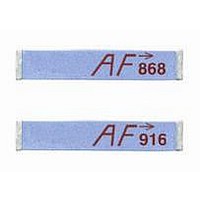AEK-916-CHP Antenna Factor, AEK-916-CHP Datasheet - Page 3

AEK-916-CHP
Manufacturer Part Number
AEK-916-CHP
Description
Antennas 916MHz Chip Ant. Eval Kit
Manufacturer
Antenna Factor
Datasheet
1.ANT-916-CHP-B.pdf
(7 pages)
Specifications of AEK-916-CHP
Dimensions
0.63 in L x 0.12 in W x 0.07 in H
Impedance
50 Ohms
Operating Temperature Range
- 40 C to + 85 C
Technology Type
Chip Antenna Evaluation Kit
Frequency
916 MHz
Bandwidth
10 MHz
Gain
+ 0.5 dBi
Lead Free Status / RoHS Status
Lead free / RoHS Compliant
Page 4
Dielectric Constant Width/Height (W/d)
A transmission line is a medium whereby RF energy is transferred from one
place to another with minimal loss. This is a critical factor, especially in high-
frequency products, because the trace leading to the antenna can effectively
contribute to the length of the antenna, changing its resonant bandwidth. In order
to minimize loss and detuning, some form of transmission line between the
antenna and the RF stage should be used, unless the antenna can be placed
very close (<1/8in.) to the RF stage. One common form of transmission line is a
coax cable, another is the microstrip. This term refers to a PCB trace running
over a ground plane that is designed to serve as a transmission line between the
RF stage and the antenna. The width is based on the desired characteristic
impedance of the line, the thickness of the PCB, and the dielectric constant of
the board material. For standard 0.062in-thick FR-4 board material, the trace
width would be 111 mils. The correct trace width can be calculated for other
widths and materials using the information below. Handy software for calculating
microstrip lines is also available on the Antenna Factor website,
www.antennafactor.com.
MICROSTRIP DETAILS
4.80
4.00
2.55
1.8
2.0
3.0
Effective Dielectric
Constant
3.59
3.07
2.12
Trace
Characteristic
Ground plane
Impedance
50.0
51.0
48.0
Board
MAXIMUM REFLOW SOLDERING PROFILE
Hand Soldering
Reflow Temperature Profile
The antenna is RoHS Compliant and designed to support hand or automated
assembly. To avoid damage to the part, the reflow solder guidelines found below
should be carefully followed. The antenna is single ended meaning that one pad
is electrically connected while the other is for mechanical support only. The
antenna terminals are not interchangeable so the polarity indicated in the Pin
Configuration section must be observed during assembly.
This antenna is designed for high-volume automated assembly, however, it may
be successfully attached by hand assembly techniques. A hand-solder
temperature of 225°C or lower should be used. Do not exceed a 10sec. heating
time.
The single most critical stage in the automated assembly process is the reflow
process. The reflow profile below should be closely followed since excessive
temperatures or transport times during reflow will irreparably damage the
antennas. Assembly personnel will need to pay careful attention to the oven's
profile to ensure that it meets the requirements necessary to successfully reflow
all components while still meeting the limits mandated by the antennas
themselves.
Reflow Oven: +340°C Max. (See adjoining diagram)
ASSEMBLY CONSIDERATIONS
Recommended Solder Melting Point +180°C
Absolute Maximum Solder Times
Hand-Solder Temp. RX +225°C for 10 Sec.
Hand-Solder Temp. TX +225°C for 10 Sec.
340˚C
300˚C
150˚C
100˚C
50˚C
25˚C
Temp
3
7
Do not exceed 30secs
Preheating
20
Peak temp 340˚C
25
Reflow
30
Time
Page 5









